Last weekend, elite marathoner and medical doctor Derek Li, gave a talk on heart rate training and selection of running shoes, at a Young NTUC Earth Runners talk.
Dr Li is no stranger to the local running scene. A General Practitioner with Raffles Medical Group, Dr Li has a marathon personal best of 2 hours 42 minutes, set at the Boston Marathon in 2014.
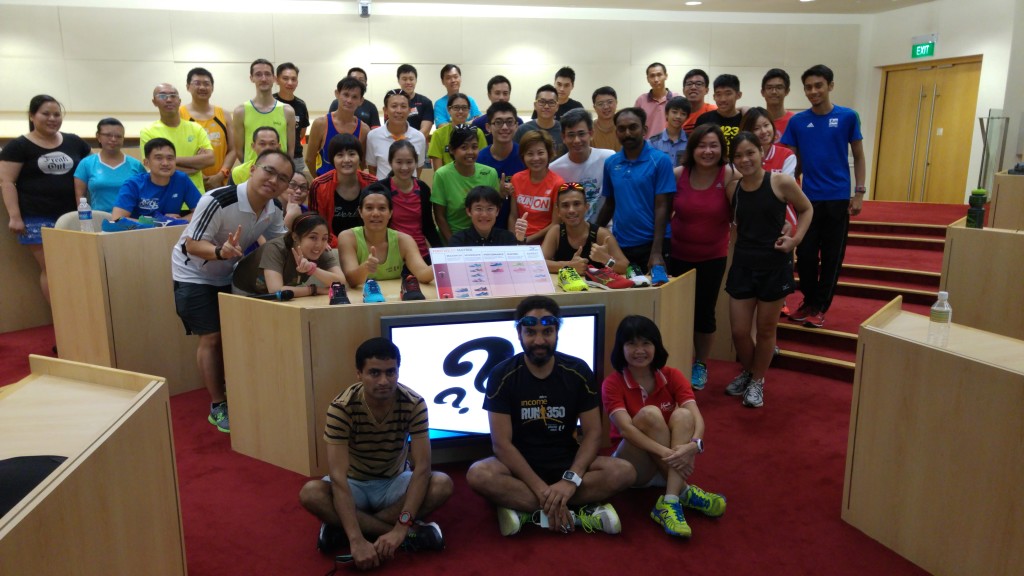
Young NTUC Earth Runners Sharing session with Dr Derek Li.
Here are the main points that Dr Li shared with participants.
Heart Rate Training
Heart rate training is typically about measuring the effort that your heart is pumping at any one time. As such, external factors such as the terrain and the heat will not affect your workout, unlike those that are measured by pace or distance.
However, Dr Li pointed out that there are some things to watch out for in your heart rates, for example, the lag time. So for instance, if the hill is 100m high, the numbers on your heart rate monitor would only rise at about 50m into the hill, so you may not realise whether you are running uphill too fast, until it is too late.
Many people have a heart rate monitor inbuilt into their GPS watches, but according to Dr Li, not all of them may know how to use it properly. And if you don’t, you can get a heart rate trainer – which will set you back by about $100 to 150 each.
External factors affecting heart rate
According to Dr Li, there are a few external factors that may affect heart rates. So if you want to determine what your most accurate heart rate is, you should measure your resting heart rate, that is, when you first wake up in the morning. Your heart rate should be the lowest at that time of the day. It will gradually rise throughout the day, due to factors such as dehydration, stress and light exercises.

If you are feeling lethargic, you could be overtraining.
Photo by intheloop.com.sg
Overtraining can also affect your heart rate. For example, when you may have already hit your tipping point and you feel really exhausted. So you cannot seem to run very fast no matter how much effort you put in, and your heart rate is still spiking like crazy. When this happens, you should take a break.
On the other hand, overtraining can also manifest in the form of a very low heart rate primarily due to stress hormones being raised in overtraining and as such, this suppresses your heart rate. So it stays down no matter how fast you are running. This is a bad sign – and it means that your body is telling you that it needs to rest.
Working within your heart rate zones
Running and exercising based on your heart rate, is the best way to base your exercise and training sessions around, according to Dr Li.
To work out your heart rate zones, tests such as the VO2 Max test (which measures the maximum volume of oxygen that an athlete uses for sports) and the Maximum Heart Rate test (which measures the maximum level that your heart rate can go during vigorous sports) can be used.
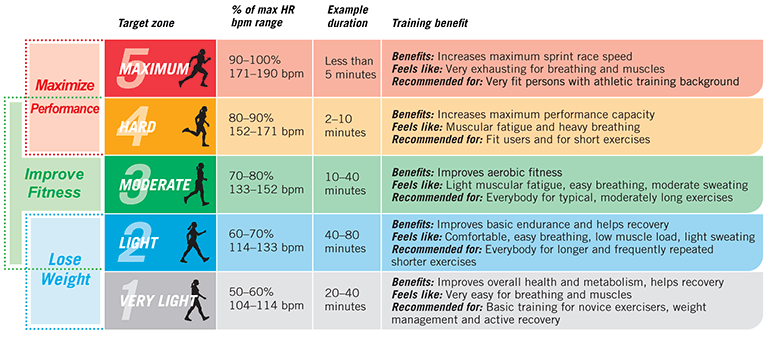
Try to exercise within your heart rate zones.
Photo by shiftucc.wordpress.com
Once your zones are determined, you would then do most of your training in Zones 2 (easy jogging pace where you can conduct an entire conversation with a friend) and Zone 3 (a running pace that you are able to sustain for at least 1 to 1.25 hours).
But Dr Li pointed out that it is very important when exercising, to stay in the targeted heart rate zones as your heart rate will invariably rise with exercise. So if you have to slow down your pace or even do some walking just to stay within the zone, then that is highly recommended. There is no point in using a heart rate monitor to train if you are just going to jump from one zone to the next. And if that is what you end up doing, then you may as well simply run by feel, instead.
For hill workouts, Dr Li also says that many people, even with heart rate monitors, tend to run up too fast, because of the lag time taken for the device to pick up a jump in the heart rate. The best and most efficient way to train hills generally, is to run uphill at a 5% harder effort and downhill at a 5% easier effort. For example, if you are running on flat ground at 6mins/km pace, then run uphill at 6.15mins/km pace and go downhill at 5.45mins/km pace. Doing this will help to keep your heart rate in a consistent zone.
Weight Loss and Heart Rate Zones
The doctor also added that if you are using running to target weight loss, then you should target a low heart rate. That’s because the higher your heart rate goes when running, the more carbs and therefore less fats you will burn.
Running on an empty stomach in the mornings will also help to burn fats because the glycogen from the previous night’s dinner would be already used up. So the body will have less sugar to work with, and would thus try to burn fats – the next best source of fuel. This may be hard at first if your body has been used to burning carbs but you will get used to it over time though.
Choosing the right running shoes
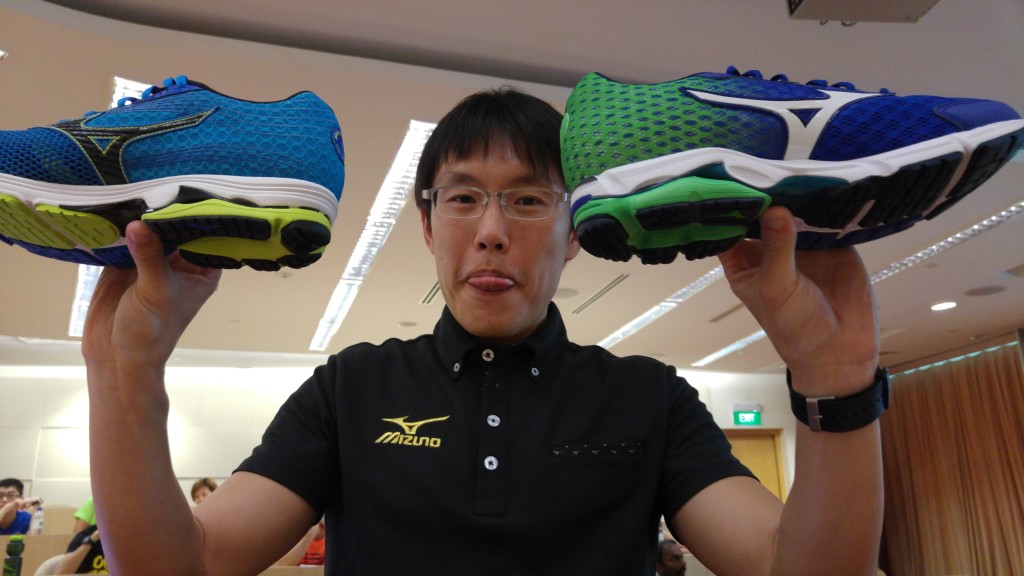
Dr Li shares more about how to choose running shoes.
According to Dr Li, different running shoes have different purposes – there is no such thing as a multi-purpose shoe.
For racing or speed work, the shoes that are typically used, have rubber soles for grip and are lightweight and designed for speed. They can last about 500kms per shoe. Dr Li advises that they are not appropriate for long or easy runs, though.
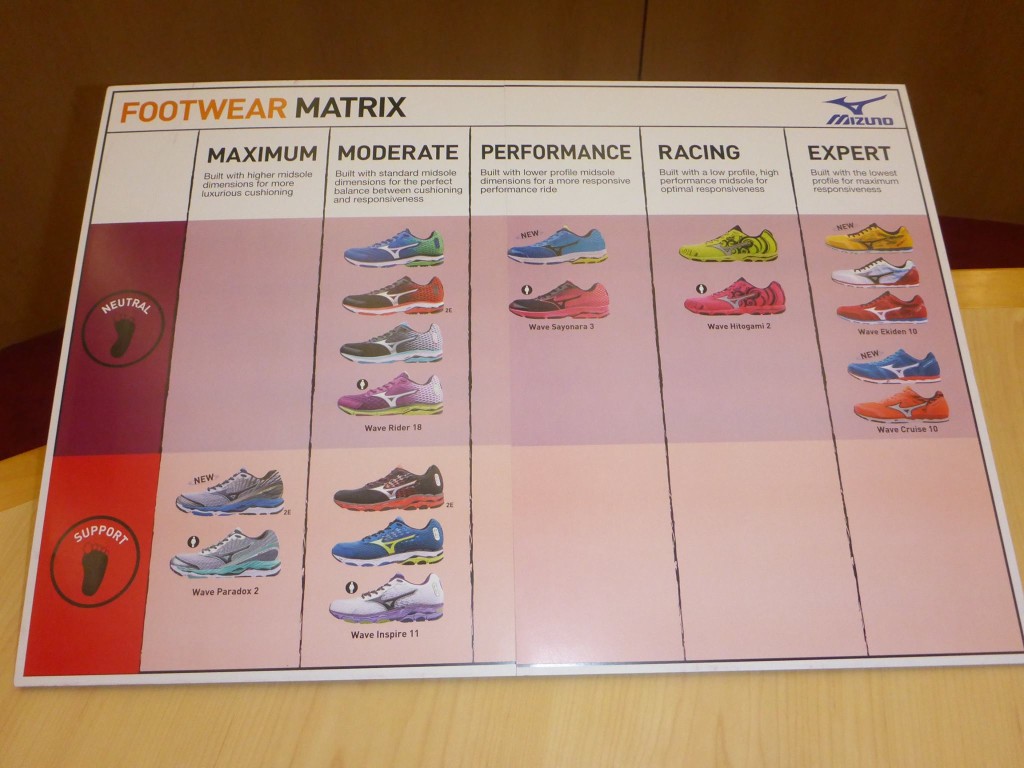
There is no such thing as a multi-purpose running shoe.
Photo By Tan Kim Lai.
Lightweight trainers, which have more cushioning compared to racers, can be used for uptempo or long interval runs as well as longer races. But as these shoes have less foam compared to daily trainers, their lifespan would also be less.
Daily trainers are for endurance running, and they comprise of the most foam in the centre and plenty of rubber in the outsole. They can last easily for more than 1,000km, which can translate to roughly six months.
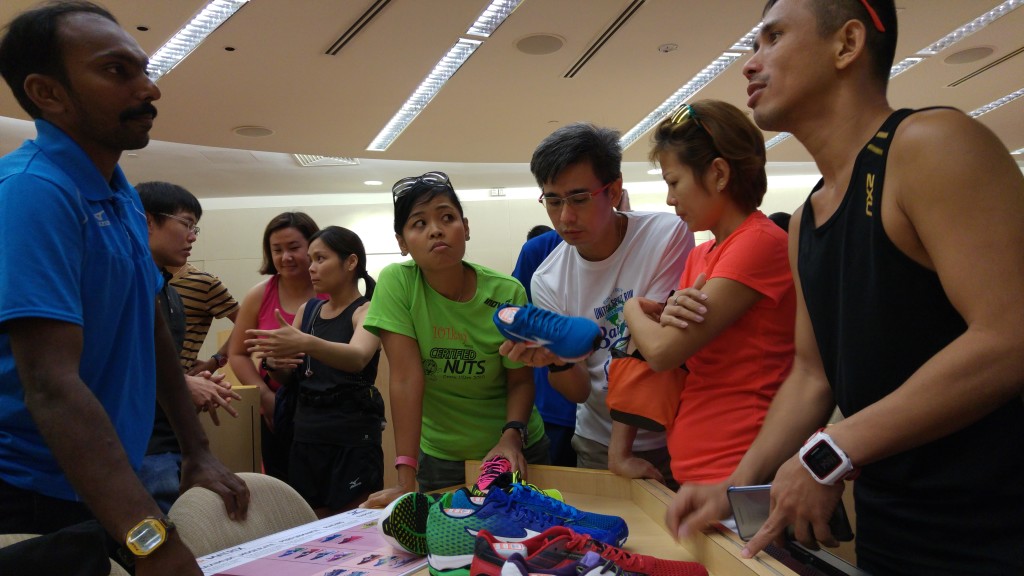
A discussion on the various types of running shoes in the market is taking place.
Premium daily trainers which are the most cushioned types of shoes, are typically used for long runs and easy runs as well as endurance running sessions.
Besides the outsole, the feel of the insole also makes a difference to the running shoes. For example, a heavy cushioned trainer is not the same as a racer – and people should preferably use races when they are running for speed. Dr Li added that if you put the insole from a cushioned trainer and into a racer, it will feel completely different in terms of the depth and feel of the shoe, but at the same time, it may actually help to prevent deterioration in the racer. So it may help if you are a runner with a natural high foot arch.
Dr Li also pointed out that different shoes will feel different – and if you run with the correct shoes, it will feel comfortable, but if for example, you try and take a cushioned shoe and try to run at a fast pace, it will feel like quicksand.
So in order to make your shoes work for you, use them for what they are supposed to do. While injuries may not manifest in the short term by using the wrong shoe, you will eventually put yourself at a higher risk of injuries, by choosing the wrong running shoe to meet your needs.
Running Styles
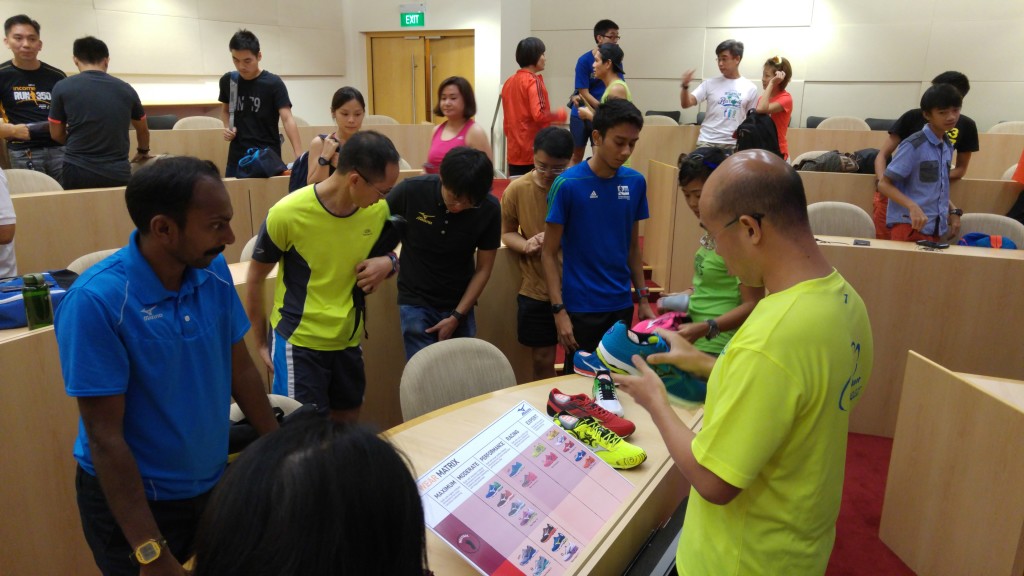
Runners wondering if they have been wearing the right type of shoes.
The marathoner also touched on running styles and pointed out that your running style does not matter and that there is no specific type of style that is recommended over the other. Instead, the main thing when running, is to be efficient and injury-free.
While Dr Li is pretty neutral about barefoot running and wearing zero-drop shoes, he says that it is important to get used to this style and train gradually. Running 20km barefoot when you are used to wearing shoes, is a sure way to get injured. But if you have been used to barefoot running since young, then Dr Li has no problems with that.
Pronation
Besides the three main running styles, some runners also tend to pronate when they run. Pronation is actually a natural movement of the foot that causes it to roll outwards to inwards and to spread the body weight over a wider area when you run. But the size of your arch can affect your ability to roll your foot and this causes under-pronation or over-pronation as a result.
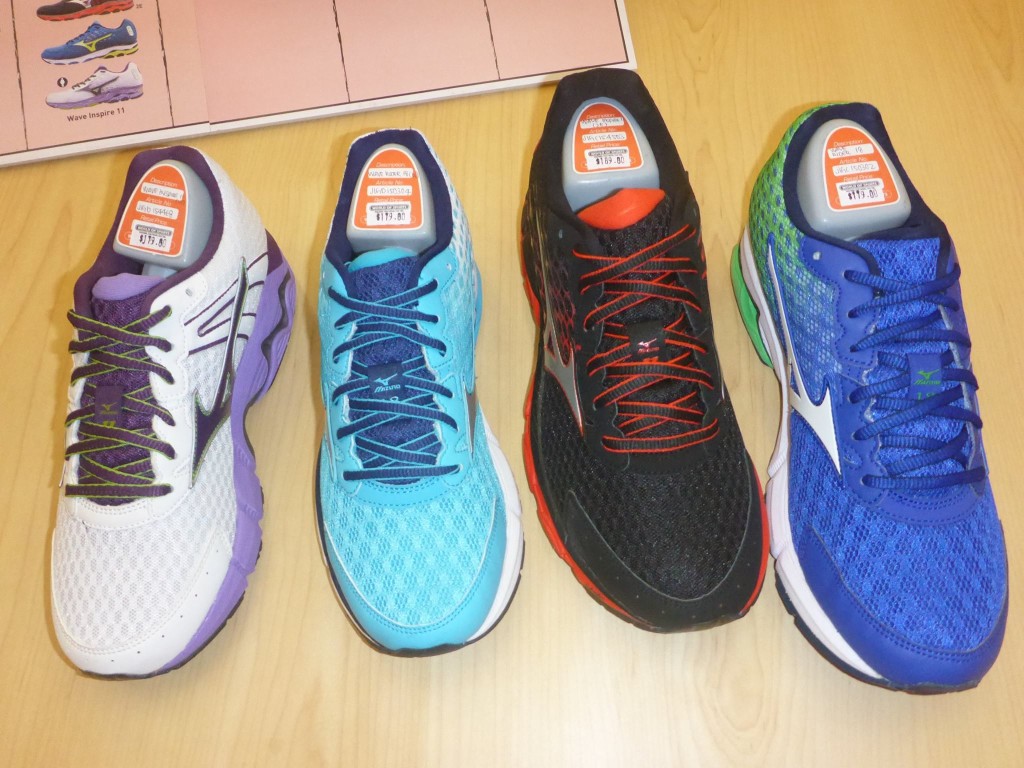
Wearing the right type of shoes to run, is important
Photo by Tan Kim Lai
These are usually corrected with relevant pronation shoes, by running on a treadmill in a shoe store and having the staff there to determine your pronation style.

Good n appropriately described
Thanks. Dr Li gave a very informative talk.